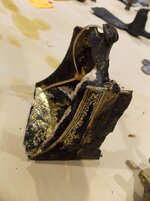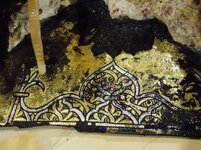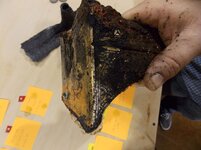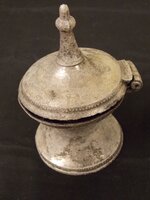ScubaFinder
Bronze Member
- Jul 11, 2006
- 2,220
- 530
- Detector(s) used
- AquaPulse AQ1B - AquaPulse DX-200 Magnetometer
- Primary Interest:
- Shipwrecks
We (Anchor Research and Salvage, a Global Marine Exploration, Inc. company) recovered this stirrup last year from the Punta Cana Pewter Wreck off the east coast of Hispaniola (Dominican Republic). This ship has re-written history books on 16th century pewter trade and has delighted scholars and pewter collectors with never before seen examples of many early 1500's pewterers. This stirrup is made of iron, and then it was chemically etched so that the gold foil could be burnished down to form a mechanical connection. This stirrup was obviously meant for royalty, which makes sense because we believe this is the ship that was carrying the new governor and vice-governor of Cuba in late summer of 1555. It is well documented that it wrecked en route, Diego de Mazariegos Guadalfajara survived to take his post as governor of Cuba a year later, but Martinez (who was to become the vice-governor) perished along with his family in the wreck.
We got this stirrup in our last division and I put it in a very low-voltage low-current electrolytic reduction bath to loosen up the coral encrustation. Being iron based with gold and silver foil on it, conservation will be a delicate process but the end result should be quite stunning. I will update this thread when it is complete with some final pictures. You can see here that some of the iron is deteriorated, but only maybe 10% so we should still have a really nice artifact when complete. I attached a photo of a Pewter Salt Container that came in with the same batch also. Enjoy!
Jason
We got this stirrup in our last division and I put it in a very low-voltage low-current electrolytic reduction bath to loosen up the coral encrustation. Being iron based with gold and silver foil on it, conservation will be a delicate process but the end result should be quite stunning. I will update this thread when it is complete with some final pictures. You can see here that some of the iron is deteriorated, but only maybe 10% so we should still have a really nice artifact when complete. I attached a photo of a Pewter Salt Container that came in with the same batch also. Enjoy!
Jason
Attachments
Last edited:











